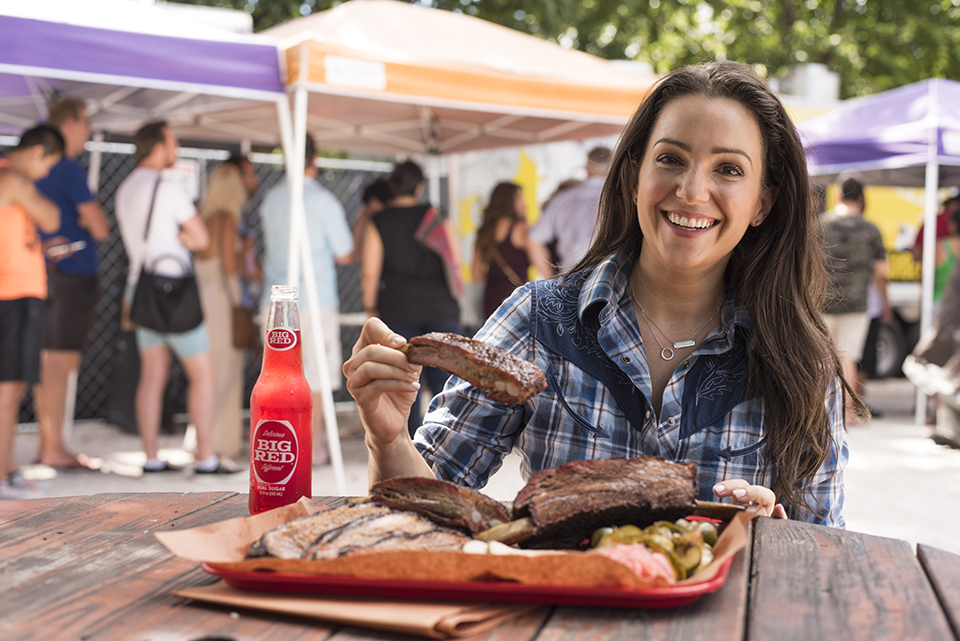Butcher Breakdown

The meat market can be an intimidating place. Although many omnivores would love to take time to chat with their local butcher about different cuts, shoppers tend to stay in their comfort zone. And why wouldn’t you? Why would you dish out the money for a decadent slab of prime rib without the knowledge of how to cook it properly? Whether you gravitate toward lean sources of protein, like to get down and dirty with barbecue, or want to treat yourself to a porterhouse, knowing how to choose and treat different cuts is the first step to meat mastery.
Expert Advice
Jessica Pryles, Austin-resident and professional hardcore carnivore
She’s a cook, writer, and TV personality specializing in red meat. We’ve peppered (pun intended) her tips and recommendations throughout this feature.
Jess Pryles’ Austin BBQ Picks
– Beef ribs at La Barbecue
– Brisket at Freedmans
– Stiles Switch BBQ has the largest selection in town. “They do a smoked prime rib one day a week and it’s phenomenal.”
Let's learn about meat! Keep reading!
U.S. Department of Agriculture Beef Grades
Not sure what cut of meat to get? Local butcher shop and salumeria , Salt & Time, will make suggestions and even let you taste their cured meats before buying.
All meat is inspected by the USDA, but only some are graded. It follows a specific grading system to evaluate tenderness, juiciness, and flavor. The assessment is largely focused on marbling, or rather, the amount of fat and distribution of fat in each piece of meat.
Select
Most likely the type of meat you’ll find in a package at the grocery store. It’s the least marbled, which means it’s a leaner cut. To compensate for the lack of flavor, coat the steak with a strongly seasoned dry rub or a salty marinade (soy or Worcestershire-based).
Choice
There is a wide variation among choice grade steaks. Some have enough marbling to pass beyond the “select” label, while some have a hefty amount but aren’t quality enough to fall into the “prime” category. Choice is a quality steak if it’s cut from the rib or loin area of the animal.
Prime
This is the type of meat you’re paying high-dollar for at upscale steakhouses. Derived from steers with lots of intramuscular fat (and therefore packed with flavor). Prime grade makes up less than three percent of the market. It’s naturally tender and tasty, so salt and pepper are the only seasonings this cut needs.
Let's learn about meat! Keep reading!
Mythbusters
#1 Add salt then cook at your leisure.
If you’re going to add salt, put it on the meat either immediately before cooking, or hours prior. The salt is going to draw the moisture out and won’t have a chance to return back into the muscle if you wait 15 to 20 minutes.
Pro tip: always pat down raw steaks with a paper towel. Absorbing the moisture on the outside will help you obtain that delicious brown crust.
#2 Getting a bone-in piece of meat means more flavor.
“If you’re talking about a steak or roast, there’s nothing in the bone that leaks out into the meat and provides extra flavor,” Pryles says. “Having the bone in ensures you’re not overcooking that side.” It protects the meat, but doesn’t do anything for flavor.
#3 Only flip your steak once.
Confusion surrounding the one-flip tip may have originated from burger cooking techniques. When cooking a burger patty, a single flip is recommended to build a crust that’ll keep the ground beef compact. However, with a steak it’s okay to turn the meat more than once. As food scientist and writer Harold McGee has explained, by flipping frequently, the meat on any given side will neither release nor absorb a significant amount of heat with each turn.
Let's learn about meat! Keep reading!
Tools of the Trade
Meat thermometer
For beginners wanting to become king (or queen) of the grill: “Get yourself a good quality meat thermometer when you’re starting out,” Pryles advises. Cooking temperatures are not debatable. Medium cooked will always be 155 degrees when it’s removed from the grill. Using a meat thermometer will groom you to better gauge cooking times.
Cast Iron Skillet
A cast iron skillet reaches high heat and retains that temperature. Other pans tend to fluctuate, which can prove challenging for even-cooking. Cast iron pans will help you get that nice sear to lock in flavor.
Rest Up
Athletes aren’t the only ones who need rest to be their best. Resting your meat is just another integral part in creating a beautifully succulent dish. You’ve already put in the work to prepare and cook it, so don’t let it go to waste by cutting your meat too soon. Give your steaks about five minutes (or until the internal temperature is 120-125 degrees) to rest after removing it from the pan or grill to ensure optimal juiciness.









